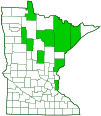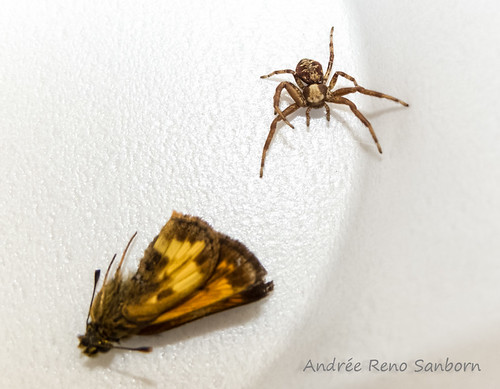punctated ground crab spider
(Xysticus punctatus)
Conservation • Description • Habitat • Biology • Distribution • Taxonomy
Conservation Status |
|
|||||||
| IUCN Red List | not listed |
|||||||
| NatureServe | NNR - Unranked |
|||||||
| Minnesota | not listed |
|||||||
Description |
||
Punctated ground crab spider is a small crab spider. It occurs in the northern United States and across southern Canada. It is uncommon in Minnesota. It is found from May through August on tree foliage forests and woodlands. Adults are hard-bodied and bristly. The female is 3⁄16″ to ⅜″ (5.4 to 8.7 mm) in length and has a legspan of ½″ to 11⁄16″ (12 to 18 mm). The male is much smaller, ⅛″ to 3⁄16″ (3.5 to 5.0 mm) in length. The plate (carapace) covering the front part of the body (cephalothorax) is moderately high, slightly longer than wide, and smoothly rounded on the sides when viewed from above. When viewed from the side it is slightly convex, highest near the front, and it drops down toward the back near the base of the third pair of legs. The sides of the carapace are dark brown. There is a broad pale stripe in the middle that narrows toward the rear, and there is a narrow pale line on each lateral margin. The area around the eyes is pale. The rear of the carapace is overhung by the abdomen. There are eight eyes arranged in two curved rows of four. The front (anterior) row is curved forward and the rear (posterior) row is curved backward. The lateral eyes are larger than the median eyes and are on low raised projections (tubercles). The anterior median eyes (AME) are closer to the anterior lateral eyes (ALE) than to each other. The posterior median eyes (PME) are closer to each other than to the posterior lateral eyes (PLE). The median ocular area (MOA), the area defined by the middle four eyes is broader than long and slightly narrowed in front. The plate on the face above the mouth (clypeus) is armed with several long spines. The jaws (chelicerae) are small and have no teeth. The abdomen is large, broadly oval, widest toward the rear, and flattened above. It is mostly brown with a broad, sharply irregular stripe in the middle. It is pale around the outside edges and there are also short black bands on the rear half. The legs are stout and fairly long. The first and second pairs of legs are long, strong, spiny, and nearly equal in length. They are normally held out and forward, like a crab. This is the feature that gives the family Thomisidae its common name. The third and fourth pairs are shorter and nearly equal in length. On the first pair, the third segment (femur) is slender and about four times longer than wide, and the fifth segment (tibia) has 3 or 4 pairs of stiff hairs on the upper side. The last leg segment (tarsus) on each leg has two claws at the end but these are not visible without magnification. The tarsi on all legs do not have a brush of hairs (scopula) on the underside, and there is no tuft of hairs (claw tuft) at the end on any leg. |
||
Size |
||
Female Body Length: 3⁄16″ to ⅜″ (5.4 to 8.7 mm) Male Body Length: ⅛″ to 3⁄16″ (3.5 to 5.0 mm) Legspan: ½″ to 11⁄16″ (12 to 18 mm) |
||
Web |
||
Crab spiders do not make webs. |
||
Similar Species |
||
Habitat |
||
Forests and woodlands |
||
Biology |
||
Season |
||
May through August |
||
Behavior |
||
When the legs are held out to the side the spider is able to walk forward, backward, or sideways (laterigrade). The female does not build webs, snares, or retreats. To protect its egg sac it will fold over the edge of a leaf and secure it with silk. |
||
Life Cycle |
||
|
||
Food |
||
Insects and other spiders |
||
Distribution |
||||
|
Sources |
|||
| 4/16/2022 | ||||
Occurrence |
||||
Uncommon in Minnesota |
||||
Taxonomy |
|||
Class |
Arachnida (arachnids) |
||
Order |
|||
Suborder |
Araneomorphae (typical spiders) |
||
Infraorder |
Entelegynae |
||
Superfamily |
Thomisoidea (crab and running crab spiders) |
||
Family |
Thomisidae (crab spiders) |
||
Subfamily |
Thomisinae |
||
Tribe |
Coriarachnini |
||
Genus |
|||
Synonyms |
|||
Misumenops punctatus |
|||
Common Names |
|||
punctated ground crab spider |
|||
Glossary
Carapace
The hard, upper (dorsal), shell-like covering (exoskeleton) of the body or at least the thorax of many arthropods and of turtles and tortoises. On crustaceans, it covers the cephalothorax. On spiders, the top of the cephalothorax made from a series of fused sclerites.
Cephalothorax
The front part of the body of various arthropods, composed of the head region and the thoracic area fused together. Eyes, legs, and antennae are attached to this part.
Clypeus
On insects, a hardened plate on the face above the upper lip (labrum).
Femur
On insects and arachnids, the third, largest, most robust segment of the leg, coming immediately before the tibia. On humans, the thigh bone.
Tarsus
On insects, the last two to five subdivisions of the leg, attached to the tibia; the foot. On spiders, the last segment of the leg. Plural: tarsi.
Tibia
The fourth segment of an insect leg, after the femur and before the tarsus (foot). The fifth segment of a spider leg or palp. Plural: tibiae.
Tubercle
On plants and animals: a small, rounded, raised projection on the surface. On insects and spiders: a low, small, usually rounded, knob-like projection. On slugs: raised areas of skin between grooves covering the body.
Visitor Photos |
|||||
Share your photo of this arachnid. |
|||||
| This button not working for you? Simply email us at info@MinnesotaSeasons.com. Attach one or more photos and, if you like, a caption. |
|||||
Alfredo Colon |
|||||
 |
 |
||||
MinnesotaSeasons.com Photos |
|||||
|
|||||

Visitor Videos |
|||
Share your video of this arachnid. |
|||
| This button not working for you? Simply email us at info@MinnesotaSeasons.com. Attach a video, a YouTube link, or a cloud storage link. |
|||
Other Videos |
|||

Created: 4/16/2022
Last Updated:




